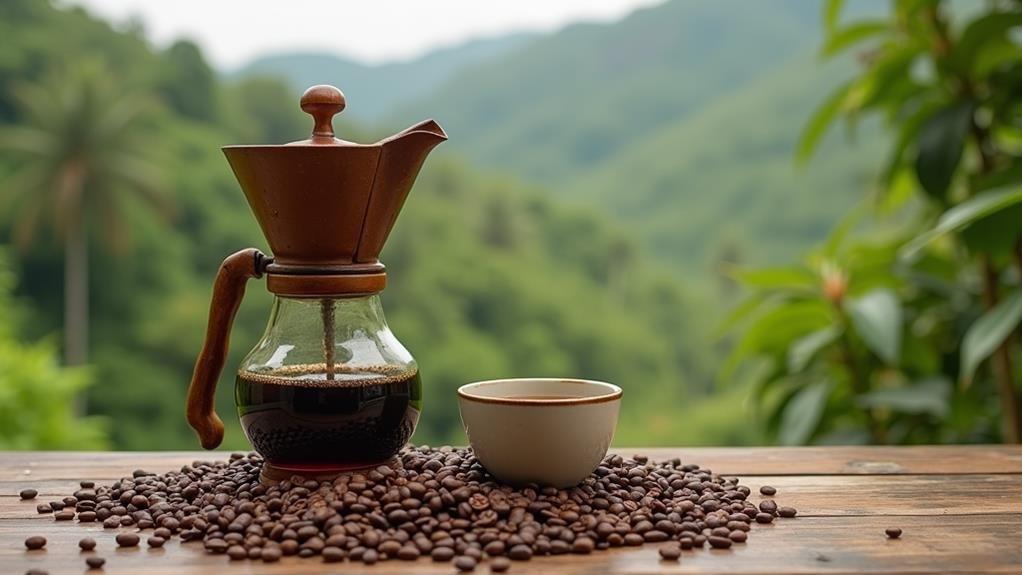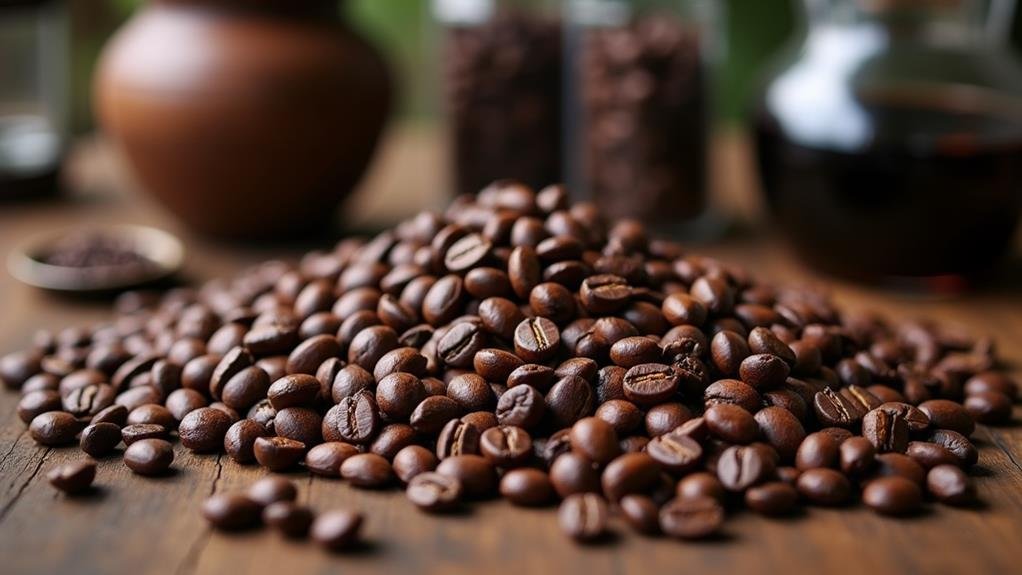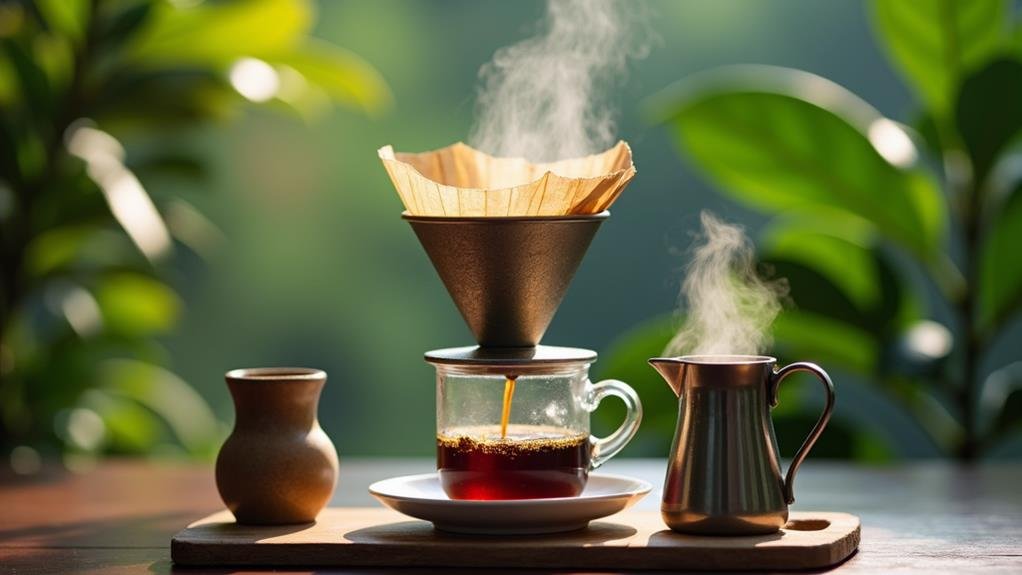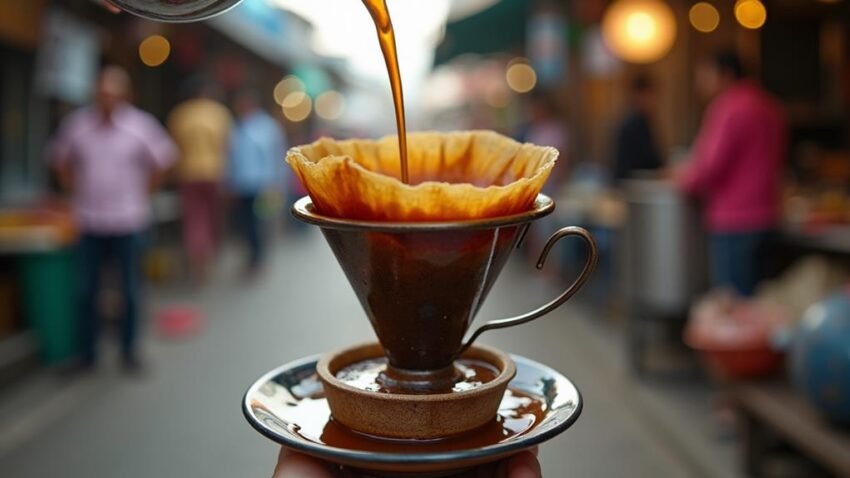You might not know that Vietnamese coffee, despite its global popularity, is still a mystery to many when it comes to its unique flavor profile. For me, the first sip of Vietnamese coffee is like discovering a hidden gem. The robust and intense flavor from the mainly used Robusta beans is balanced perfectly by hints of chocolate and caramel, creating a velvety texture that's hard to forget. But what really sets it apart is the addition of sweetened condensed milk, which adds a creamy sweetness that complements the boldness. I'm curious to explore how these elements come together to create such a distinctive taste experience.
Vietnamese Coffee Origins

Vietnamese coffee stems from beans cultivated in Vietnam's fertile highlands, especially in areas like Buon Ma Thuot. This geographical location plays a significant role in shaping the unique flavor of Vietnamese coffee. The varied geography and climate of Vietnam contribute to the distinct taste profile of its coffee.
Robusta beans, accounting for over 90% of Vietnam's coffee production, are crucial in the bold and robust flavor characteristic of Vietnamese coffee. These beans, along with traditional roasting methods, enhance the strong and nutty undertones that coffee enthusiasts enjoy.
The addition of sweetened condensed milk provides a creamy sweetness that complements these flavors, resulting in a rich and velvety texture. This combination leads to a unique taste experience that distinguishes Vietnamese coffee from other varieties.
The impact of Vietnam's geography on coffee production guarantees that each cup contains hints of chocolate and nutty flavors, making it a preferred option for many.
Understanding the origins of Vietnamese coffee helps in appreciating its intricate yet harmonious flavor profile, deeply rooted in the country's diverse geography and traditional roasting techniques. This holistic approach to coffee production contributes to its popularity globally.
Unique Flavor Profile
When you take your first sip of Vietnamese coffee, the bold and robust taste hits your palate immediately. This distinctive flavor profile is what sets Vietnamese coffee apart from other types of coffee.
Distinctive Flavor Profile Breakdown
| Flavor Component | Description | Contribution to Taste |
|---|---|---|
| Chocolate | Hints of rich, dark chocolate | Adds depth and complexity |
| Nutty | Nuttiness with subtle hints of roasted nuts | Provides a robust undertone |
| Caramel | Smooth, sweet caramel notes | Enhances the full-bodied experience |
The combination of these flavors, along with the use of Robusta beans and unique brewing methods, contributes to the unique taste of Vietnamese coffee. The smooth texture and deep, complex flavors create a full-bodied experience that is both rich and satisfying. Often sweetened with condensed milk, Vietnamese coffee gains a creamy and sweet element that complements its boldness perfectly. This blend of robust flavors and a velvety texture makes Vietnamese coffee a standout choice for those seeking a distinctive coffee experience. The unique brewing methods and Robusta beans play an essential role in achieving this distinctive taste, setting it apart from other coffee varieties.
Bean Varieties Used

Most of the distinctive flavor in Vietnamese coffee comes from the bean varieties used. Robusta beans often dominate the Vietnamese coffee scene, providing a strong and bold flavor profile that many have come to associate with Vietnamese coffee. These robusta beans are known for their rich and intense coffee experience, which is a hallmark of traditional Vietnamese coffee.
However, Arabica beans are also used in Vietnamese coffee blends to offer a more mellow and acidic taste. This blend of robusta and Arabica provides a balanced flavor that caters to different palates. For those seeking a unique and specialty coffee experience, Peaberry beans are prized for their rarity and distinct flavor profile.
The use of butter or oil in the roasting process further enhances the flavor profile of Vietnamese coffee beans. This technique can bring out nuances in both robusta and Arabica beans, adding depth to the overall taste.
Whether it's the boldness of robusta or the subtlety of Arabica, these bean varieties combined with careful roasting practices make Vietnamese coffee stand out for its rich and varied flavors. Understanding these bean varieties helps appreciate the complexity of Vietnamese coffee taste.
Roasting Techniques
When it comes to Vietnamese coffee, the roasting techniques play an important role in shaping its unique taste. Typically, Vietnamese coffee is roasted to a medium to dark level using butter or oil, which helps achieve a balanced flavor profile. This method brings out the chocolatey or nutty undertones in the beans, ensuring that the final brew has just the right balance of acidity and body.
Medium to Dark Roast
Vietnamese coffee, renowned for its bold and rich flavors, is typically roasted to a medium to dark level. This roasting technique enhances the coffee's unique taste and aroma. Here are some key points about the medium to dark roast:
- Flavor Notes: The medium to dark roast brings out less acidic brew with smoky and caramelized notes.
- Roasting Techniques: Roasting at higher temperatures for a longer duration is common, which highlights chocolatey and nutty undertones.
- Balanced Flavor Profile: The use of butter or oil during roasting helps create a balanced flavor profile.
- Unique Taste: The roasting process plays an essential role in crafting the unique taste and aroma of Vietnamese coffee grounds.
- Bold Flavors: This roast level enhances the bold flavors, making it a staple in Vietnamese coffee culture.
When you brew Vietnamese coffee, you'll notice these rich flavors immediately. The medium to dark roast is what sets it apart from other coffees, offering a depth that's hard to find elsewhere.
Whether you're looking for a strong morning coffee or an afternoon pick-me-up, the medium to dark roast of Vietnamese coffee is sure to satisfy your taste buds.
Butter and Oil Roasting
Butter and oil roasting is a distinctive method that enhances the flavor of Vietnamese coffee, especially when combined with the medium to dark roast levels discussed earlier. This technique involves roasting Vietnamese coffee beans with butter or oil, which amplifies their unique taste profile. One of the main reasons for using this method is to balance the inherent bitterness of Robusta beans, which are commonly used in Vietnamese coffee. By adding butter or oil during the roasting process, the bitterness is harmonized, creating a smoother and more enjoyable flavor.
Butter or oil roasting also contributes a luxurious, chocolatey richness to the coffee, complementing its bold and strong characteristics. This approach guarantees that the medium to dark roast levels are achieved accurately, resulting in a well-rounded and flavorful cup of coffee. The careful monitoring of this process is essential to avoid over-roasting, which can detract from the desired flavor.
Ultimately, the use of butter or oil in roasting contributes to the distinct taste that sets Vietnamese coffee apart from other varieties, making it a favorite among those who appreciate a robust yet balanced cup. This unique flavor profile is a tribute to the craftsmanship and tradition behind Vietnamese coffee production.
Balancing Flavor Profiles
Balancing the flavor profile of Vietnamese coffee is a delicate art, one that relies heavily on precise roasting techniques. To achieve the perfect blend, roasters must carefully monitor each step of the process to enhance the unique characteristics of the coffee.
- Bold and Robust Flavor: Vietnamese coffee is known for its deep, complex notes of chocolate and nuts.
- Medium to Dark Roast: Adding butter or oil during the roasting process helps balance the strong flavors of Robusta beans.
- Nutty and Caramelized Undertones: Roasting techniques bring out these undertones, adding depth to the coffee's flavor.
- Smoky Taste: The dark roast results in a smoky taste with a richer, more intense flavor.
- Lower Acidity Level: This results in a smoother drinking experience, making it more enjoyable.
Traditional Brewing Methods

When it comes to making Vietnamese coffee, the traditional method is all about patience and precision. At the heart of this process is the Phin filter, a simple yet effective tool that allows for a slow extraction process. This slow drip process is essential for developing the full flavor profile of Vietnamese coffee, resulting in a robust and aromatic cup.
Key Components of Traditional Vietnamese Coffee Brewing
| Component | Description |
|---|---|
| Phin Filter | Allows for a slow extraction, enhancing deep flavors and aroma. |
| Dark Roasted Robusta Beans | Provides a rich, smooth texture with nutty and chocolatey undertones. |
| Sweetened Condensed Milk | Balances out robust flavors, adding creamy sweetness. |
| Brewing Process | Slow drip process guarantees strong and bold flavor development. |
The use of dark roasted Robusta beans in Vietnamese coffee gives it a unique flavor profile. These beans offer a rich texture and are characterized by nutty undertones and chocolatey notes. When combined with sweetened condensed milk, these robust flavors are balanced out, creating a creamy and smooth taste experience. The traditional brewing methods of Vietnamese coffee highlight these deep, complex flavors, making every cup distinctive and satisfying.
Modern Twists and Variations
When exploring the modern twists on Vietnamese coffee, I find that innovative brewing methods and flavorful ingredient combinations offer a fresh take on the traditional drink.
Ingredients like coconut milk, egg yolks, and various spices add unique tastes and textures, catering to diverse preferences.
Innovative Brewing Methods
Innovative brewing methods have revolutionized the traditional Vietnamese coffee experience, offering unique variations that tantalize the palate. These modern twists on classic recipes have made Vietnamese coffee even more appealing to a wider audience.
- Egg Coffee: A rich, creamy coffee made by mixing a whipped egg yolk with sweetened condensed milk and strong coffee.
- Coconut Coffee: Infusing coconut milk into the brewing process for a creamy and slightly sweet flavor.
- Salted Coffee: Adding a pinch of salt to balance out the sweetness and enhance the flavor of the coffee.
- Rice Wine Infusion: Incorporating rice wine into the brewing method for a subtle, slightly sweet and boozy undertone.
- Butter Coffee: Adding butter to create a smooth, velvety texture and a hint of dairy flavor.
These innovative brewing methods, such as using different bean blends and roast levels, cater to diverse preferences. Specialty coffee shops worldwide often experiment with these variations by incorporating local ingredients for a fusion of flavors.
Despite these creative adaptations, the traditional Phin filter drip method remains popular due to its ability to emphasize robust flavors and smooth texture. This blend of traditional and contemporary techniques guarantees that Vietnamese coffee continues to evolve while preserving its unique essence.
Flavorful Ingredient Combinations
How can you elevate the already rich and bold flavor of Vietnamese coffee? One way is to explore modern twists and unique variations that enhance its distinctive flavor profile. Vietnamese coffee, known for its robusta beans and deep chocolatey, nutty undertones, gets an extra layer of luxury with the addition of sweetened condensed milk. This creamy element not only adds a sweet touch but also balances out the boldness, creating a smooth and satisfying drinking experience.
For those looking to venture beyond the traditional, there are several innovative combinations to try. Coconut-infused Vietnamese coffee brings a tropical twist, while egg yolk adds a silky texture and subtle richness. Another interesting variation involves incorporating rice wine, which introduces a slightly sweet and complex note to the brew. These unique variations maintain the core bold flavor of Vietnamese coffee while offering something new and exciting for adventurous palates.
Whether you stick to the classic or opt for one of these modern twists, you'll find that the indulgent flavor profile of Vietnamese coffee remains a consistent delight.
Health Benefits and Culture

Vietnamese coffee, with its rich aroma and distinct flavor, offers more than just an invigorating drink. It also boasts several health benefits and is deeply embedded in Vietnamese culture.
Here are some key points to take into account:
- Rich in Antioxidants: Vietnamese coffee is rich in antioxidants, which can help reduce the risk of diseases and improve cognitive function.
- Cultural Significance: It's a significant part of Vietnamese culture, often enjoyed in social settings and coffeehouses.
- Use of Sweetened Condensed Milk: The addition of sweetened condensed milk adds creaminess and sweetness, enhancing the overall flavor profile.
- Robusta Beans: Commonly made from robusta beans, Vietnamese coffee provides a strong and bold taste with higher caffeine content.
- Traditional Brewing Methods: Traditional brewing methods contribute to its unique taste and cultural significance.
These aspects not only make Vietnamese coffee enjoyable but also highlight its importance beyond just being a beverage. The robusta beans provide a bold flavor that many appreciate, while the antioxidants offer potential health benefits.
In Vietnam, coffeehouses are hubs for social interaction, making Vietnamese coffee an integral part of daily life and culture.
Conclusion
To sum up, Vietnamese coffee offers a rich and bold taste experience. The use of Robusta beans and traditional roasting techniques create a strong, intense flavor with hints of chocolate and nuttiness. Adding sweetened condensed milk balances this boldness. For example, consider visiting a café in Hanoi where locals enjoy this coffee as part of their daily routine; it's a sensory delight that showcases the cultural significance and unique flavor profile of Vietnamese coffee.

